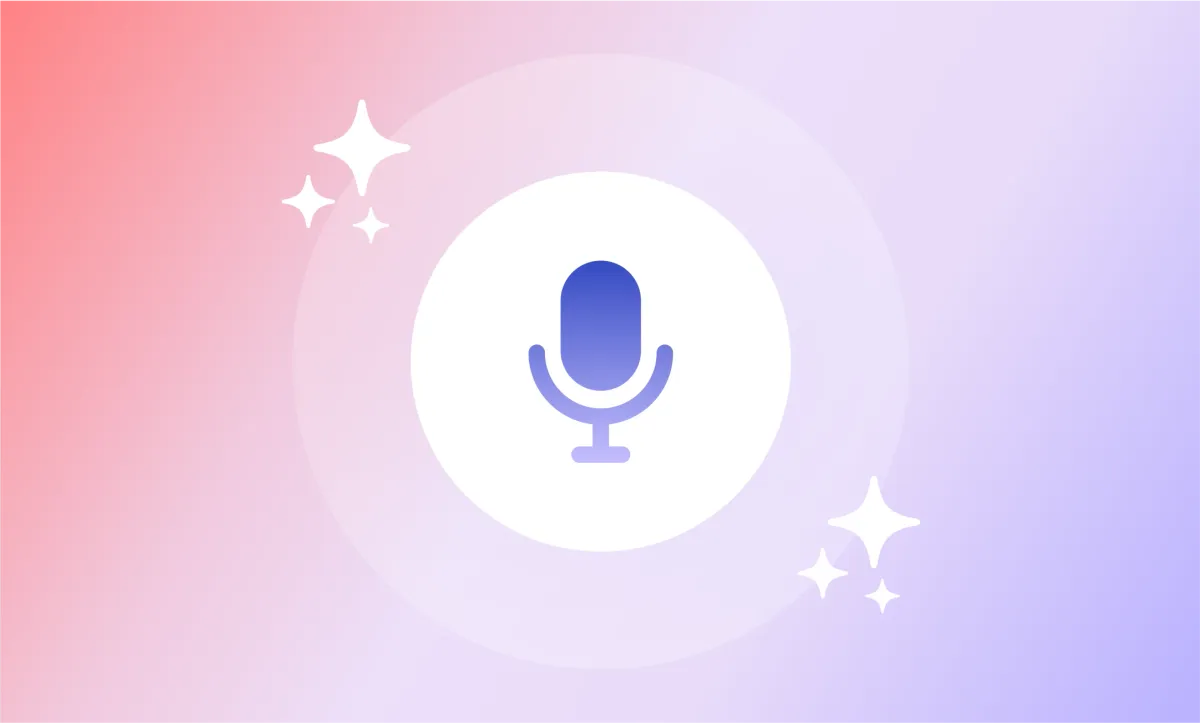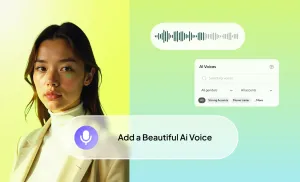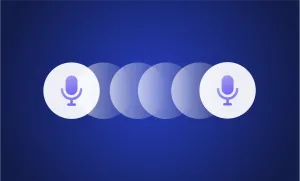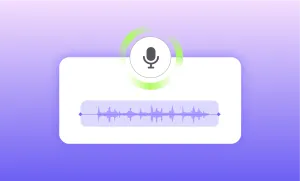Voiceovers can make or break a project. They set the tone, carry the message, and connect with the audience in ways visuals alone cannot. Whether you’re creating a podcast, producing a documentary, or crafting an ad campaign, the right voiceover can transform your content into something unforgettable.
In this guide, we’ll walk you through each voiceover style, breaking down what makes it unique, the types of projects it’s best suited for, and tips to maximize its potential.
12 (Free) AI Voiceover Styles at Podcastle
1) Commercial Voiceover
What It Sounds Like: Commercial voices are designed to grab attention. They’re polished, engaging, and often carry an energy that pulls listeners in within seconds. The tone is professional but approachable, with just the right balance of confidence and warmth.
Where It Shines: This voice style is perfect for advertisements, product launches, and brand promotions. Whether it’s a social media ad or a video campaign, a commercial voice ensures your message gets delivered with impact.
How to Use It:
- Short-form content like Instagram or YouTube ads.
- Promotional videos for products or services.
- Brand campaigns that need a consistent, high-quality voice.
Pro Tip: For maximum effectiveness, keep your scripts concise and focus on delivering a clear call to action. Pair the voice with upbeat music for added energy.
2) Storytelling Voiceover
What It Sounds Like: The storytelling voice is warm, soothing, and immersive. It draws the listener into a narrative, painting vivid pictures with every word. Pacing is key here—it’s slower and more deliberate, giving each sentence room to breathe.
Where It Shines: Storytelling voices are ideal for podcasts, documentaries, and video essays. They create a sense of intimacy and connection, making them perfect for projects that aim to educate, inspire, or evoke emotion.
How to Use It:
- Personal or branded podcasts.
- Documentaries that explore human stories.
- Explainer videos with a narrative element.
Pro Tip: Layering the voice with subtle background music can elevate the storytelling experience. Think soft piano for emotional pieces or ambient soundscapes for travel stories.
3) Character Voiceover
What It Sounds Like: Dynamic and versatile, character voices bring personalities to life. They’re playful, exaggerated, or dramatic—perfect for capturing a wide range of emotions and personas.
Where It Shines: Use character voices for animated content, video games, or audiobooks with multiple characters. They’re also great for humor-driven projects that need a unique touch.
How to Use It:
- Animation and cartoons.
- Video games that feature voiced NPCs or main characters.
- Children’s audiobooks with distinct voices for different characters.
Pro Tip: Character voices work best when paired with creative scripts. Think of how the voice’s tone, pitch, and cadence match the personality you’re portraying.
4) Informative/Educational Voiceover
What It Sounds Like: Clear, calm, and steady, this voice style is designed for clarity and comprehension. It’s approachable without sacrificing authority, making complex information easier to digest.
Where It Shines: Educational voices are a natural fit for online courses, tutorials, and corporate training videos. They’re also effective in explainer videos that break down intricate concepts for a broader audience.
How to Use It:
- E-learning platforms.
- Corporate training modules.
- Step-by-step guides and tutorials.
Pro Tip: Keep scripts free of jargon to complement the voice’s clarity. If possible, use visuals to reinforce key points and enhance understanding.
5) Virtual Voice Voiceover
What It Sounds Like: Sleek and futuristic, the virtual voice has a slightly robotic undertone while maintaining a natural feel. It conveys innovation and modernity, making it a perfect fit for tech-forward content.
Where It Shines: Ideal for tech-related projects, explainer videos, and apps requiring virtual assistant voices. It’s great for content that highlights cutting-edge technology or futuristic concepts.
How to Use It:
- Explainer videos for new tech products.
- Mobile apps with voice assistant features.
- Sci-fi-inspired content.
Pro Tip: Combine this voice with sleek visuals and modern sound effects to create a cohesive and compelling tech narrative.
6) IVR Voiceover
What It Sounds Like: Professional, polite, and easy to understand, IVR voices are tailored for automated systems. They prioritize clarity and a welcoming tone to ensure a seamless user experience.
Where It Shines: This style is essential for customer service lines, appointment booking systems, and other automated processes where clarity and efficiency matter.
How to Use It:
- Customer service helplines.
- Automated booking or inquiry systems.
- Company voicemail recordings.
Pro Tip: Use concise, user-friendly language in your scripts. Avoid long sentences to ensure smoother delivery and better user comprehension.
7) Audiobook Voiceover
What It Sounds Like: A mix of expressive narration and dramatic inflection, the audiobook voice is all about immersion. It brings stories to life with nuanced delivery and varied pacing.
Where It Shines: Audiobook voices excel in fiction, memoirs, and non-fiction. They’re perfect for creating an intimate listening experience, whether the content is entertaining or informative.
How to Use It:
- Audiobooks for all genres.
- Serialized podcast fiction.
- Long-form storytelling projects.
Pro Tip: Experiment with multiple AI voices for books with multiple characters. This adds depth and variety to the listening experience.
8) Movie Trailer Voiceover
What It Sounds Like: Big, bold, and dramatic, this voice style is designed to captivate audiences instantly. It’s intense and larger-than-life, making it impossible to ignore.
Where It Shines: Movie trailers, gaming promos, and high-energy intros benefit most from this voice style. It’s also great for any content that needs a sense of grandeur or excitement.
How to Use It:
- Trailers for movies, games, or events.
- YouTube channel intros.
- High-stakes promotional content.
Pro Tip: Keep scripts short and punchy. The power of a movie trailer voice lies in its ability to say a lot with just a few words.
9) Newscasting Voiceover
What It Sounds Like: Authoritative and neutral, the newscasting voice commands attention without being overbearing. It’s articulate and steady, delivering information with professionalism.
Where It Shines: This voice style is perfect for news-style updates, formal announcements, and recap videos. It’s built for trust and clarity.
How to Use It:
- Daily or weekly news updates.
- Company announcements.
- Recap videos for events or conferences.
Pro Tip: Match this voice with a visually clean and professional layout to enhance credibility.
10) Podcast Voiceover
What It Sounds Like: Conversational, relaxed, and personable, this voice style mimics natural dialogue. It’s all about creating a connection with the audience and fostering engagement.
Where It Shines: Podcasts, casual interviews, and solo narrations are the ideal playground for this voice style. It’s also great for long-form discussions.
How to Use It:
- Hosting podcast episodes.
- Casual video narrations.
- Engaging with audiences through conversational tones.
Pro Tip: Use this voice for dynamic podcasts where tone consistency is key. It’s versatile enough to work across multiple genres.
11) Motivational Voiceover
What It Sounds Like: Uplifting and energizing, motivational voices are designed to inspire and empower. They’re confident, with a tone that encourages listeners to take action.
Where It Shines: This voice style is perfect for motivational speeches, personal growth content, and life coaching videos. It’s all about leaving the audience feeling energized.
How to Use It:
- Inspirational videos for social media.
- Keynote-style presentations.
- Personal development podcasts.
Pro Tip: Combine motivational voices with powerful visuals and music for an unforgettable experience.
12) Strong Accents
What It Sounds Like: This voice style incorporates regional or cultural accents, adding authenticity and personality. It’s perfect for creating a localized feel or connecting with specific audiences.
Where It Shines: Use strong accents for global campaigns, storytelling with cultural elements, or any content that benefits from a touch of regional flavor.
How to Use It:
- Branded content targeting specific demographics.
- Animated series or games with diverse characters.
- Storytelling that celebrates cultural diversity.
Pro Tip: Choose an accent that resonates with your target audience. It’s a great way to build connection and authenticity.
The Right Voice for the Right Story
Every voice has a story to tell, and every project has a voice that’s just right for it. With Podcastle’s diverse range of AI voices, you can experiment, create, and find the perfect tone to match your content’s vision. Whether you’re aiming for bold and dramatic or calm and educational, the possibilities are endless.
Ready to bring your projects to life? Explore our voiceover styles today and let’s make something unforgettable.








